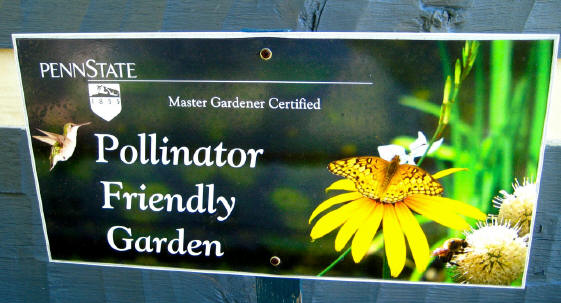 Today was a very happy day in my garden because I saw honeybees among the other pollinators. I had not seen honeybees in my gardens since spring. Their population has become so reduced and so endangered that while I used to take them for granted as always
being around, now it is an event to see them. My gardens are "Penn State Extension Master Gardener Certified Pollinator Friendly" and as a result of my gardening practices, I have a host of other pollinators. Among them are several types of bumblebees, mason bees, butterflies, moths, flies, wasps, hummingbirds, ants and even beetles. A pollinator is defined as an agent
that moves pollen from the male anthers of a flower to the female flower stigma to accomplish fertilization leading to seed production.
Today was a very happy day in my garden because I saw honeybees among the other pollinators. I had not seen honeybees in my gardens since spring. Their population has become so reduced and so endangered that while I used to take them for granted as always
being around, now it is an event to see them. My gardens are "Penn State Extension Master Gardener Certified Pollinator Friendly" and as a result of my gardening practices, I have a host of other pollinators. Among them are several types of bumblebees, mason bees, butterflies, moths, flies, wasps, hummingbirds, ants and even beetles. A pollinator is defined as an agent
that moves pollen from the male anthers of a flower to the female flower stigma to accomplish fertilization leading to seed production.
Anyone can implement the steps and gardening practices needed to certify a garden as "Pollinator Friendly" thereby helping to protect important pollinators. Pollinator friendly gardens provide necessary food and habitat. Information that follows comes from the Penn State Extension website. There you will find the practices and requirements for sustaining and promoting
pollinators and the procedures to become a certified garden. Such information can be found at: http://www.psu.edu/ by entering "pollinator certification" in the search box.

A pollinator friendly garden strives to provide pollen and nectar sources from early spring to late fall. This is accomplished by planting a variety of preferably native trees, shrubs, perennials and annuals having a variety of flower shapes and sizes.
- Choose a variety of colors to attract a diversity of pollinators.
- Plant in groups or drifts to make the flowers easily visible to pollinators.
- Avoid modern hybrids, especially those with "double" flowers, where plants may offer little to no pollen or nectar due to flower shape or breeding that reduces them.
Native plants are the heart of a pollinator friendly garden. Research shows that native plants are four times more attractive to pollinators than non-natives. Planting natives will supply pollinators with the nutrition needed to thrive. Natives are well adapted to survive in a particular geographic area. Because they occur naturally, an added benefit is that native
plants usually require less care and maintenance and are more resistant to disease.
Plants that are host foods for the larvae (caterpillars) of butterflies and moths are critical since without host plants for the larvae there would be no butterflies and moths. Many butterfly larvae feed only on one or two specific plants such as Monarch caterpillars who only eat milkweed, and Spicebush swallowtail caterpillars feed mainly on spicebush and sassafras.
Holes in the leaves of these plants mean they are doing their job of providing food to pollinators.
Pollinators need sources of water for drinking and reproduction. Butterflies, for example, will gather and sip at shallow pools, mud puddles or even birdbaths. A garden may already have a natural water source, such as a pond or stream. If not, create a water source by adding a birdbath or a puddling area such as a low-sided container of water with small rocks. I use a
large glazed flowerpot saucer for a water source for butterflies and wasps in my garden.
A good way to encourage pollinators to visit your garden is to provide nesting sites. Bumblebees and many solitary bees nest in the ground and need open patches of soil. Dead wood provides nesting areas for a variety of pollinators such as other types of bees, wasps, beetles and ants. Many solitary bees nest in the pithy center of stems and twigs or provided nest
sites. Create nesting sites out of an untreated wood block by drilling a number of holes approximately ¼ inches in diameter, and 3-5 inches deep or purchase commercial mason bee tube bundles. Mount them on a post or under the eave of a garage or shed to give protection from rain.
Pollinators also need protection for overwintering, so instead of cleaning up gardens in the fall, wait until late spring. Many larval pupae such as those of the eastern black swallowtail butterfly overwinter in the ground below their larval host plants. Perennials and grasses left standing can provide them shelter while providing winter interest in a garden.
Identify existing invasive plants on your property and initiate a plan to remove them. Invasive plant species endanger pollinator habitat. An invasive plant is an alien species whose introduction does or is likely to cause economic, environmental, or human health harm. Invasive species out-compete native species for food and water, may carry disease, contribute to the
decline of threatened and endangered species, prey on native species, and change biodiversity by overgrowing and crowding out native species.
Some common garden plants on the invasive list are:
- Japanese Barberry (Berberis thunbergii)
- Burning Bush (Euonymus alatus)
- Autumn Olive (Elaeagnus umbellata)
- Privet (Ligustrum species)
- Bush Honeysuckles, Tartarian, Amur, (Lonicera species)
- Oriental Bittersweet (Celastrus orbiculatus)
Pesticides do not distinguish between pests and beneficial insects, thereby harming beneficials that actually are targeting pests in your garden. Many common garden insecticides are deadly to all forms of beneficial bee and wasp. Use fewer or less toxic pesticides such as insecticidal soap and horticultural oil and apply them late in the day when pollinators are not
present. Avoid systemic pesticides since they move throughout the entire plant including pollen and nectar making it toxic. It becomes deadly to both pests and beneficial insects such as butterfly and moth caterpillars and bees.
Visit http://www.psu.edu/ and enter pollinator certification in the search box. There you will find all of this information in much more detail and all of the necessary steps required to certify your garden as pollinator friendly. Complete the application and submit it along with photos or a sketch of your gardens and a $10 cost for the certification. If desired, one
can purchase the sign shown in the photo for an additional $30 to proudly display in your yard after receiving certification. It lets everyone know you are supporting our valuable pollinators.
Read other articles on ecological gardening & native plants